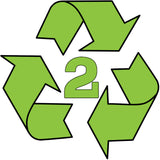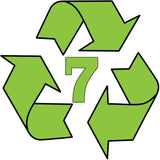Hey baby, can I get your number?
Not all plastic is created equal. Some are easily recycled, some are not recyclable at all. Some are fine for human health, and some want to mess us up. Some plastic is unidentifiable and we don't even know what their MO is.
You've probably noticed that many plastic bottles and packaging identify their type of plastic by stamping one of these symbols on them:
They're called Resin Identification Codes (or RIC for short) and were introduced in 1988 to help recycling companies efficiently sort the increasing amount of plastic they were receiving. Each type of plastic has to be recycled independently in order to maximize the integrity of the output.
This is a great first step in know how to recycle properly, but as you'll see below, it's not as straight forward as you may think.
Let's break it down (pun attempted, target missed. Plastic doesn't break down.).

PET or PETE (Polyethylene Terephthalate, but only their mother calls them that) is a pretty popular plastic, the fourth most created plastic of the crew, and one of the easiest to recycle. It's commonly found in everyday single-use items such as water and soda pop bottles, peanut butter jars, and condiment bottles, as well as household materials like carpet and furniture.
Despite being used for way too many food items, this type of plastic is not considered safe to reuse, because it absorbs bacteria and flavours making it difficult to properly clean. The bigger health concern about ol' PETE is that as it ages -and particularly when heated- it begins to leach phthalates and antimony. Click on the links for a more detailed explanation of those chemicals, but in a nutshell they're endocrine disrupters, possibly carcinogen, and can cause respiratory and cardiac issues. 😬

PETE also has a family on the side in the textile industry, where they hooked up with Cotton and named their baby Polyester. Polyester is used for thermal wear, athletic wear, and really sexy leisure suits.
The textile industry is a massive contributor to the landfill, largely because these mixed materials can't be recycled or easily biodegrade. Polyester also sheds microplastics in the wash and from friction when worn, all of which bioaccumulate in the environment and our food system.

HDPE (High-density Polyethylene). As far as plastic goes, this one is the best of the bunch. HDPE is both safe to reuse and easy to recycle because it has a high strength to density rating. It is common for HDPE to be used for household items such as: milk and laundry detergent jugs, patio furniture and outdoor toys, and pipes for drinking water and sewage. Because HDPE is resistant to chemicals it's also commonly used for gasoline jerry cans and household and industrial chemical packaging.

PVC (Vinyl or Polyvinyl Chloride). We're assigning this one a failing grade. PVC is neither safe to reuse nor easy to recycle. PVC is commonly used in building for windows, siding, wire covers, and gutters because it withstands weathering, has good electrical properties and has low gas permeability.

However, PVC leaches all kinds of terrible stuff, which makes it a bit concerning that it's widely used in children's toys, baby teethers, pet toys, and plastic food wrap. You probably also have PVC credit and identification cards and a full body catsuit.
LDPE or PE-LD (Low Density Polyethylene) is safe to reuse but not easily recycled, making it one of the leaders in plastic pollution. Because of this, it's ideal to avoid purchasing items made of #4 in the first place and make sure to reuse and/or upcycle these items wherever possible. However, as a strong, yet flexible material, many housewares are made from LDPE such as containers, trash cans, and squeeze bottles. Make sure you take care of these items so they last as long as possible; which is theoretically 500 to 100 years.
Commonly used for plastic food bags, including: bread, sandwich, and freezer, and garbage and grocery bags (though, aren't they the same thing?). This is also the most likely plastic coating to be used in cardboard milk cartons and disposable coffee cups, which is why they're not recyclable. What's more, even though they're BPA free, they leach estrogenic chemicals like most plastic - yet another reason why you should always use a travel mug (like this one, for example 😉 ).
LDPE is also a terrible plastic because it releases two greenhouse gases, methane and ethylene when exposed to sunlight, making it a concern for our climate crisis.
PP, or Polypropylene if you're being formal. Like LDPE, it's a safe plastic to reuse because it doesn't seem to leach chemicals, but is not easily recycled. You'll therefore find this type of plastic made into many many food storage containers, including single use items such as drinking straws (boo!), yogurt containers (boo!) and plastic cups (boo!). It's also commonly used for personal care items like prescription bottles, baby bottles, diapers, and menstrual pad liners.
However, new studies in recent years are warning of microplastic shedding in PP baby bottles, where they account for 82% of the market. The microplastic shedding is also exasperated because bottles are typically warmed up before using, which increased the shedding. PP is also used for household kettles, so if you have one, it's time to upgrade to a stainless steel, glass, or stovetop model.
PPS. It's neither reusable or easy to recycle. Hard pass on this one, please.
Polystyrene, aka styrofoam, is still used for packaging food for some reason even though it's know to leach styrene which is "reasonably anticipated to be a human carcinogen". For reasons unknown, it's still used for toys, coffee cup lids, egg cartons, and disposable cutlery.
Consider this one a skip, and avoid it whenever and wherever possible. It accounts for 35% of all US landfill material, which is an awful lot.
O. Other. It that shall not be named. We don't know what it is, so let's call it 7.
May or may not be acrylic, nylon, polycarbonate or polylactic acid. Without specific identification, #7 is best avoided. It's not recyclable and it may not be safe. Ideally we should all avoid purchasing items make or packaged in #7 as it'll eventually make its way into the environment where it may never breakdown.
 Bonus Plastic: PLA
Bonus Plastic: PLA
PLA plastics also fall into #7. PLA stands for Polylactic Acid, which is a fancy way to say it's a bioplastic made from renewable sources, such as corn, cassava, sugarcane or sugar beet pulp. Hopefully one day PLA will outgrow their starter home and invest in their own number, as it's becoming increasingly popular as an alternative to petroleum based plastic.
All Plastics
All plastics, except PLA, are made from petroleum (oil + natural gas) which is a non-renewable natural resource. Greenhouse gases are released during the extraction processing, and eventual decomposition of plastic. Plastic isn't biodegradable, and can live on this earth for 500+ years. While they degrade, they realize greenhouse gases, chemicals and toxins into the environment. As they break down into smaller and smaller pieces, they become known as micro or nano plastics, which bioaccumulate in the ecosystem, killing countless marine life, and eventually finding their way into our bodies (recent studies have found microplastics in human tissue, blood, and placenta).
All plastics may leach estrogenic chemicals, and some even contain BPA (bisphenol A) which is a proven toxin used in rigid plastics that has serious adverse health effects. Always look for a BPA-free label on any plastic product, particular one that is used with children or for food.
Even if you memorize the RICs above, they're not a hard and fast rule, because:
- many plastics aren't labelled (it's a voluntary system)
- they don't inform whether the plastic has been mixed with dyes, fragrances or other chemicals that affect its recyclability
- your community may not have the ability to recycle that type of plastic
TLDR/
- All plastic suck for being unsustainable
- All plastics can leach estrogenic chemicals
- Some plastics leach BPA which is very very bad
- It's only safe to reuse plastics #4 and #5, and #2 but that one isn't easily recycled
- Try to avoid plastics #1, #3, #6 and #7
- Plastics #7 is a catch all category that can include BPA chemicals
- PLA plastic is well intended, but most facilities aren't equipped to process it. Yet.













